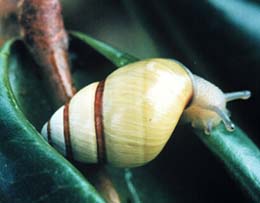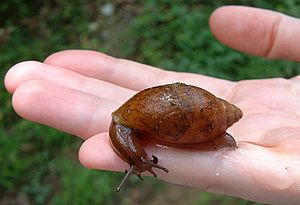Rosy wolfsnail facts for kids
Quick facts for kids Rosy wolfsnail |
|
|---|---|
 |
|
| A live individual of Euglandina rosea | |
| Scientific classification | |
| Kingdom: | |
| Phylum: | |
| Class: | |
| (unranked): |
clade Heterobranchia
clade Euthyneura clade Panpulmonata clade Eupulmonata clade Stylommatophora informal group Sigmurethra |
| Superfamily: |
Oleacinoidea
|
| Family: |
Spiraxidae
|
| Genus: |
Euglandina
|
| Species: |
E. rosea
|
| Binomial name | |
| Euglandina rosea |
|
| Synonyms | |
|
|
The rosy wolfsnail, also called the cannibal snail, is a type of medium to large land snail. It breathes air and is a mollusk that eats meat. Its scientific name is Euglandina rosea.
This snail is a very fast and hungry hunter. It actively searches for and eats other snails and slugs. The rosy wolfsnail was brought to Hawaii in 1955. The idea was to control another invasive snail, the giant African land snail. However, the rosy wolfsnail caused a big problem. It is responsible for the disappearance of about eight native snail species in Hawaii. Because of this, it is now on a list of the top 100 most invasive species in the world.
Contents
What Does It Look Like?
The rosy wolfsnail usually lives for about two years. Its eggs hatch in 30 to 40 days. Young snails become adults and can have babies when they are 4 to 16 months old. This snail can move quite fast for a snail, about 8 millimeters per second.
Its body is light grey or brown. The two lower tentacles on its head are long and almost touch the ground. The shell is typically about 76 mm (3 inches) tall and 27.5 mm (1 inch) wide. It is shaped like a spindle, meaning it tapers to a point at both ends.
The shell has a narrow, oval-shaped opening. The part of the shell near the opening (called the columella) is shortened. The shell itself has a brownish-pink color. A fully grown adult snail can be between 7 and 10 cm (3 to 4 inches) long.
How It Lives
The rosy wolfsnail naturally lives in the Southern United States. You can often find it in hardwood forests and even in city gardens. It is a quick and hungry hunter that eats other snails and slugs.
Smaller prey snails are swallowed whole. Larger ones are sucked out of their shells. This is why it earned the nickname "the cannibal snail." Rosy wolfsnails follow the slime trails of other snails to find food and mates. They spend over 80% of their lives following these trails. They prefer to eat smaller snails because they are easier and quicker to catch.
The rosy wolfsnail is specially built for eating meat. Its mouth parts are inside a beak-like snout that can stretch out. This allows its toothed tongue, called a radula, to reach into its prey. The radula is large, and its teeth are shaped like long cones.
Predators and Diseases
Rats, tenrecs, pigs, and mongooses are the main animals that eat rosy wolfsnails. Rats chew off the top of the snail's shell. Tenrecs crack the shell into big pieces. Pigs tend to crush the entire shell. Mongooses attack the snail's body directly.
Sometimes, adult rosy wolfsnails have been seen eating each other. However, this only happens when they are kept in captivity. It seems to be very rare in nature.
Diseases can also cause rosy wolfsnails to die. One known disease is caused by a type of bacteria called Aeromonas hydrophila. Snails get infected by eating contaminated food or by touching another infected snail. This disease makes it hard for them to digest food. They become very thin, even if there is plenty of food, and eventually die from starvation.
Reproduction and Life Cycle
The rosy wolfsnail is a hermaphrodite, meaning it has both male and female reproductive parts. It is also oviparous, which means it lays eggs instead of giving birth to live young.
Their courtship starts with one snail following another's slime trail. The snail that is following then climbs onto the back of the other snail's shell. After climbing on, the pursuing snail shakes its head strongly for about 15 minutes. This is followed by a short quiet period. Then, the mounted snail turns its head to face its own shell.
After this, the snails mate. The one snail stays on the other's shell. Their heads come together and twist around each other's necks. This mating can last up to four hours. An adult snail lays 25 to 35 eggs in a shallow hole in the soil. The eggs hatch after 30 to 40 days.
The snail is known to go into a resting state, like hibernation, during winter. It usually comes out in April or May.
Where It Lives
The rosy wolfsnail is originally from the Southeastern United States. This includes states like Florida and Georgia. Other types of snails in the same group (genus Euglandina) are found in South and Central America.
Why It's an Invasive Species

The rosy wolfsnail has become an invasive species in many places outside its home range. A big example is Hawaii. These predatory snails were first brought to Hawaii to try and get rid of another invasive species, the giant African land snail.
In 1955, snails were collected from Florida and sent to Hawaii. That same year, 616 rosy wolfsnails were set free on the island of Oahu. By 1958, 12,000 more were taken from Oahu and released on eight other Pacific islands. However, this plan did not work to reduce the giant African snail population. Instead, it caused a sharp drop in the number of native Hawaiian snails.
The introduced rosy wolfsnails aggressively attacked the native O'ahu tree snails. Many tree snail species were hunted to extinction very quickly. These predatory snails continue to be a big danger to the local snail populations.
About 70% of all known mollusk extinctions since the year 1500 have happened on islands. It is believed that about one-third of these extinctions were caused by the rosy wolfsnail. The native snails were at high risk because they reproduce very slowly. The rosy wolfsnail has caused about eight native snail species in Hawaii to disappear forever. Because of this, the International Union for Conservation of Nature (IUCN) has listed the rosy wolfsnail among the top 100 worst invasive alien species in the world.
How to Control Them
One way to protect native snails from the rosy wolfsnail is to raise the native tree snails in captivity. Then, small groups are released into a special forest area that is safe from predators. This safe area has a metal barrier around it. At the bottom of the barrier, there is a plastic trough filled with salt and electric wires. This creates a protected space with both chemical and electrical defenses. The enclosure allows native snails to breed safely, but it keeps them from leaving the protected area.
Other ways to control the rosy wolfsnail have been looked into. The three main methods are collecting them, using chemicals, and using biological control. Collecting them is not used much because it takes a lot of time and effort. Chemical poisons have been used in many areas, but they are not very good at controlling the snail population. Biological control, which means using other living things to control them, has been a more popular idea.
Rules and Laws
The rosy wolfsnail is now legally considered a "noxious species" in French Polynesia. This means that live rosy wolfsnails cannot be brought to these islands. The IUCN also states that bringing in the rosy wolfsnail is now officially discouraged everywhere.
See also
 In Spanish: Caracol lobo para niños
In Spanish: Caracol lobo para niños



